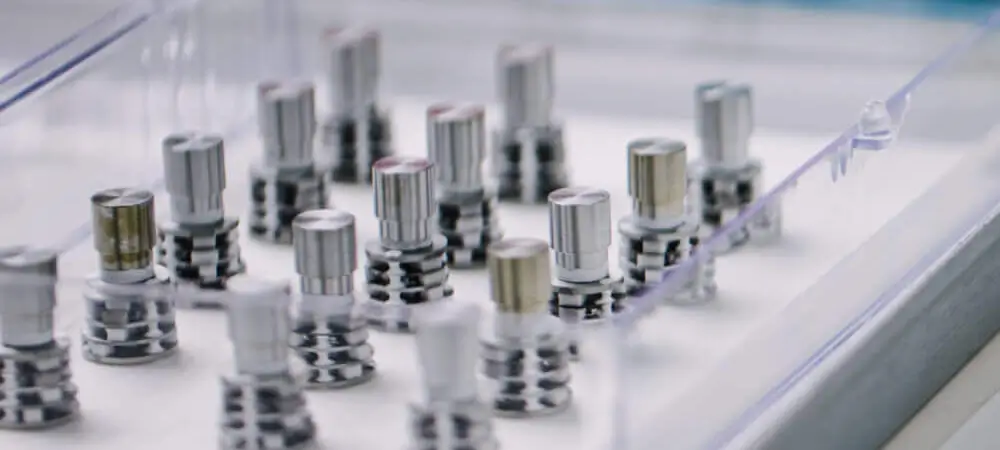Hydrogen brazing is a specialized metal-joining process that uses high-purity hydrogen gas to enhance the flow and wetting of brazing alloys. The general process involves heating components in a furnace with a steady stream of hydrogen gas, which acts as a cleaning agent during the process, reducing surface oxides and contaminants that allow for more effective adhesion.
Hydrogen brazing is crucial in precision manufacturing because it creates high-integrity joints essential for high-performance components. The process ensures clean, oxide-free interfaces, which are critical for achieving strong metallurgical bonds. This is particularly important in industries like aerospace, medical devices, and research equipment, where reliability and precision are paramount.
Whether you have a wet or dry hydrogen brazing application, Elcon Precision provides a full suite of services that are tailored to each customer's specific needs. If you're unsure if your application requires atmospheric or vacuum brazing, our team of experts will be able to determine the best path forward to achieve success with your project.
Understanding the Difference Between Wet & Dry Hydrogen Brazing
Wet Hydrogen Brazing:
The wet method uses hydrogen gas to control the moisture content to minimize surface oxides and contaminants. This method is ideal for copper and stainless steel alloy applications where the moisture improves wetting and removes the residual hydrocarbons.
The process involves placing the components into our furnace, which can accommodate up to 12" in diameter and 20" in overall length. We then add the ideal level of wet hydrogen. Depending on the alloy in process, we crank the heat to upwards of 1,500°F and begin the brazing process with the specifically chosen filler metal. Once complete, we allow the components to cool before going into inspection, where we ensure the process creates a strong, successful joint.
Dry Hydrogen Brazing:
The dry method is relatively the same process, but instead, we use dry hydrogen, which is almost completely moisture-free. This process is better suited for materials like molybdenum, tungsten, or stainless steel with a high chromium level, where oxides are formed at relatively low dew points; the dry process ensures oxide-free results. Our hydrogen brazing process is often used to join ceramics like aluminum oxide (alumina) to metals like stainless steel, kovar, or tungsten.
For these applications, we use the same practices of cleaning the components, metallizing (if required), assembling and brazing them in our furnaces. We heat the furnace to similar temperatures depending on the alloy and perform our brazing process with the selected filler metal. We then perform a controlled cooling of the components to prevent oxidation and maintain joint integrity.
What's The Big Difference:
The obvious is that wet is moisture-controlled, and dry is almost entirely void of moisture. The bigger difference is the material used and whether you're trying to reduce hydrocarbons or oxidation. Regardless, our highly skilled staff is here to help guide you toward successfully brazed components.
Recognizing the Pros and Cons of Each Method
Wet Hydrogen Brazing
Advantages: Copper and stainless alloy versatility, enhanced hydrocarbon removal, improved wetting, generally cost-effective.
Disadvantages: Potential oxidization and contamination, which are detrimental to high-precision applications, and limited material selection based on the aforementioned potential disadvantages.
Dry Hydrogen Brazing
Advantages: Increased compatibility for oxidation-sensitive materials like molybdenum and tungsten, contaminant-free environment, suited for high and ultra-high vacuum applications, and more consistent results.
Disadvantages: Less hydrocarbon removal can result in more post-process cleaning and generally higher costs based on equipment and consumables required.
Critical Difference Between Success and Failure
Aerospace components vary from Traveling Wave Tubes (TMTs) used in communication and radar systems to thermal management systems and high and ultra-high vacuum environments.
Medical devices range from X-ray tubes for imaging, gas delivery systems, sensors within diagnostic equipment, and also implant devices like pacemakers.
Research equipment, including vacuum chambers used for scientific experiments or electrostatic chucks used in semiconductor manufacturing.
How Elcon Precision Ensures Project Success
Elcon’s decades of experience means we’ve encountered and solved dozens of challenges. Our expertise helps us continuously improve our processes, and we’re ready to help you throughout the design phase.
Over the years, we've identified the bottlenecks in the procurement process that would typically delay the innovation or completion of your project. To ensure our clients avoid those delays, we regularly review the critical aspects of the manufacturing process that we can bring in-house, where it coincides with our skill set, to create a more streamlined process. This applies to material sourcing, machining, and plating operations through final quality inspection in our certified clean rooms and facilities.
Ready For Your Next Hydrogen Brazing Challenge
Depending on whether the main objective is oxidation or hydrocarbon control and what materials we'll be using, we will have a better understanding of which method would be ideal. That being said, every application is unique and presents various challenges, which may require an unorthodox approach. Now that we've explored the benefits and differences of wet and dry hydrogen brazing, we hope this helps guide you throughout your design phase.
Elcon Precision is prepared to lend our expertise to determine the best method for your application and help you navigate the associated challenges. Request a quote from our team of experts today, and we’ll get in touch shortly.

